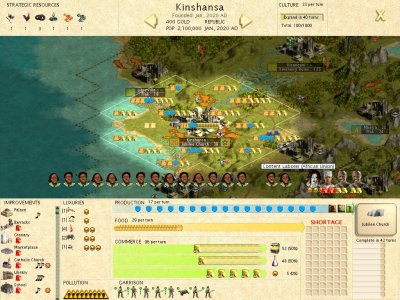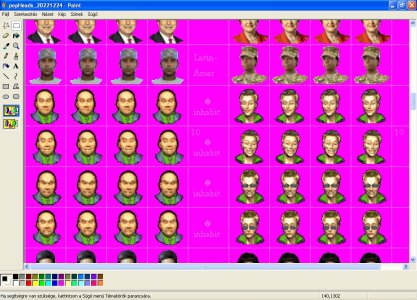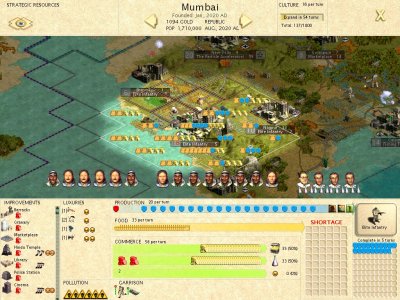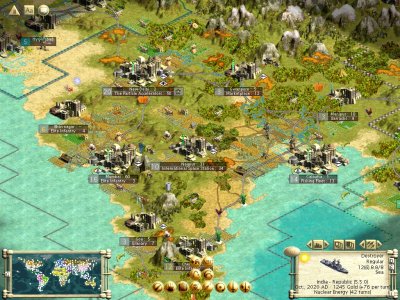Hi All,
I changed the food, shield and commerce values of the terrain squares.
I took the following aspects into account: I considered the area's characteristics, Timerover Naval Mod's biq files gave me many good ideas and I also reviewed Swargey's Archipalego-D2.biq file.
Until now, the deserts could not be watered in the EGMI game mod either, since in reality it would be very uneconomical and impractical to water the Sahara, they don't even do it. deserts cannot be irrigated, but there are many natural treasures hidden in the desert soil.
Semi-deserts are slightly better than wild deserts, here it already gives +1 food, irrigation adds +2 food
Semi-deserts are usually transitional zones between plains/savannas and deserts.
Plains and savannas give +2 food, if they are irrigated, they also get +3 food.
The grassland alone then gives +3 food, since the best quality land on earth, with irrigation, gives another +4 food (see Ukraine is one of the world's largest grain producers due to its territory).
Peat Moss gives less food than grassland, it only gives +2 food with irrigation +3 food, but with building a mine it gives +2 shield
Tundra has not changed.
In the floodplain, in a relatively narrow strip, it gives a lot of food due to the occasional floods: +4, and irrigation it gives +6 food.
The hills give +5 shield after building a mine, but the loess gives +2 food 1 food place, there only after building a mine it gives +3 shield
The mountains then give +2 shield, if a mine is ready, it adds +10 shield. The high mountains give +3 shields, but the mines here only give +5 shields, since it is difficult to operate a high mountain mine in real life.
I didn't change the forest, but the rainforests give +1 commerce
I did not change the jungle, marsh and volcano values.
Coastal waters give +2 food and +2 shield and +2 commerce.
The sea gives +2 food +1 shield and +1 commerce and the cold seas are very rich in food, so it gives +3 food, the oceans also give +1 food,+1 shield and +1 commerce.
more here:
Changes in soil food, shield and trade production(I marked in red where I changed the value): F = Food S = Shields C = Commerce I (F) = Irrigation (Food) M (S) = Mining (Shields) R (C) = Roads (Commerce)
Desert: before: F: 0, S: 1 C: 0; I (F): 0, M (S): 1, R (C): 1 then: F: 0, S: 1 C: 0; I (F): 0, M (S): 1, R (C): 1
Semi Desert: before: F: 0, S: 1 C: 0; I (F): 1, M (S): 1, R (C): 1 then: F: 1!, S: 1 C: 0; I (F): 2!, M (S): 1, R (C): 1
Plains: before: F: 1, S: 1 C: 0; I (F): 1, M (S): 1, R (C): 1 then: F: 2!, S: 1 C: 0; I (F): 3!, M (S): 1, R (C): 1
Savanna: before: F: 1, S: 0 C: 0; I (F): 1, M (S): 0, R (C): 1 then: F: 2!, S: 0 C: 0; I (F): 3!, M (S): 0, R (C): 1
Grassland: before: F: 2; S: 0; C: 0; I (F): 1, M (S): 1, R (C): 1 then: F: 3!, S: 0 C: 0; I (F): 4!, M (S): 1, R (C): 1
Peat Moss: before: F: 2; S: 0; C: 0; I (F): 1, M (S): 0, R (C): 1 then: F: 2; S: 0; C: 0; I (F): 3!, M (S): 2!, R (C): 1
Tundra: before: F: 1, S: 0 C: 0; I (F): 0, M (S): 1, R (C): 1 then: F: 1, S: 0 C: 0; I (F): 0, M (S): 1, R (C): 1
Flood Plain: before: F: 3; S: 0; C: 0; I (F): 1, M (S): 0, R (C): 1 then: F: 4!; S: 0; C: 0; I (F): 6!, M (S): 0, R (C): 1
Hills: before: F: 1, S: 1 C: 0; I (F): 0, M (S): 2, R (C): 1 then: F: 1, S: 1 C: 0; I (F): 0, M (S): 5!, R (C): 1
Loess: before: F: 1, S: 1 C: 0; I (F): 0, M (S): 1, R (C): 1 then: F: 2!, S: 1 C: 0; I (F): 0, M (S): 3!, R (C): 1
Mountains: before: F: 0, S: 1 C: 0; I (F): 0, M (S): 2, R (C): 1 then: F: 0, S: 2! C: 0; I (F): 0, M (S): 10!, R (C): 1
High Mountains: before: F: 0, S: 1 C: 0; I (F): 0, M (S): 0, R (C): 1 then: F: 0, S: 1 C: 0; I (F): 0, M (S): 1, R (C): 1
Forest: before: F: 1, S: 2 C: 0; I (F): 0, M (S): 0, R (C): 1 then: F: 1, S: 2 C: 0; I (F): 0, M (S): 0, R (C): 1
Rain Forest: before: F: 1, S: 2 C: 0; I (F): 0, M (S): ?2, R (C): 1 then: F: 1, S: 2 C: 1!; I (F): 0, M (S): 0, R (C): 1
Jungle: before: F: 1, S: 0 C: 0; I (F): 0, M (S): 0, R (C): 1 then: F: 1, S: 0 C: 0; I (F): 0, M (S): 0, R (C): 1
Marsh: before: F: 1, S: 0 C: 0; I (F): 0, M (S): 0, R (C): 1 then: F: 1, S: 0 C: 0; I (F): 0, M (S): 0, R (C): 1
Volcano: before: F: 0, S: 3 C: 0; I (F): 0, M (S): 0, R (C): 0 then: F: 0, S: 3 C: 0; I (F): 0, M (S): 0, R (C): 0
Coast: before: F: 1, S: 0 C: 2; I (F): 0, M (S): 0, R (C): 0 then: F: 2!, S: 2! C: 2; I (F): 0, M (S): 0, R (C): 0
Sea: before: F: 1, S: 0 C: 1; I (F): 0, M (S): 0, R (C): 0 then: F: 2!, S: 1! C: 1; I (F): 0, M (S): 0, R (C): 0
Cold Sea: before:: F: 1, S: 0 C: 1; I (F): 0, M (S): 0, R (C): 0 then: F: 3!, S: 0 C: 1; I (F): 0, M (S): 0, R (C): 0
Ocean: before: F: 0, S: 0 C: 0; I (F): 0, M (S): 0, R (C): 0 then: F: 1!, S: 1! C: 1!; I (F): 0, M (S): 0, R (C): 0











